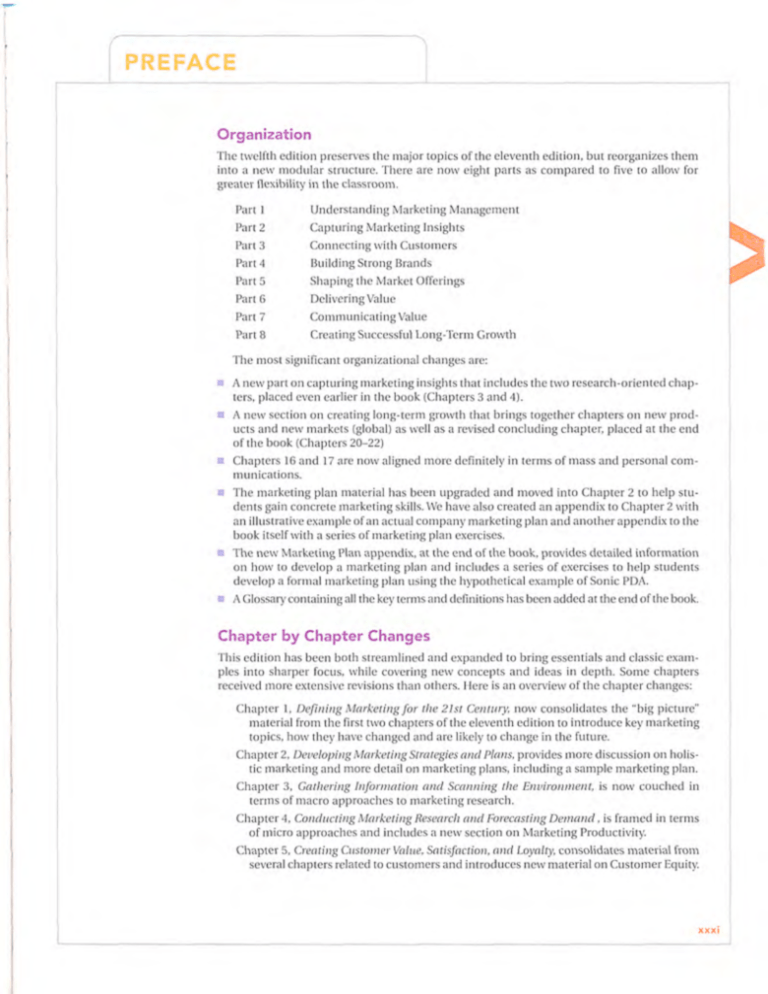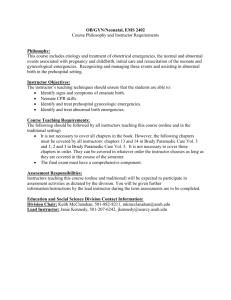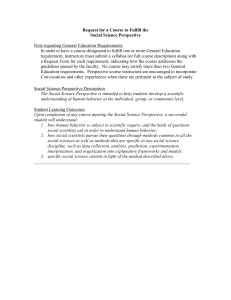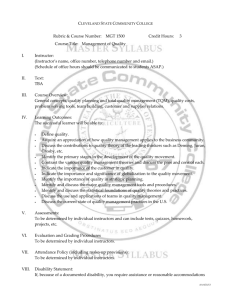Organization - e-Marketing
advertisement

Organization The twelfth edition preserves the major topics of the eleventh edition, but reorganizes them into a new modular structure. There are now eight parts as compared to five to allow for greater flexibility in the classroom. Part 1 Part 2 Part 3 Part 4 Part 5 Part6 Part 7 Part 8 Understanding Marketing Management Capturing Marketing Insights Connecting with Customers Building Strong Brands Shaping the Market Offerings Delivering Value Communicating Value Creating Successful Long-Term Growth The most significant organizational changes are: i A new part on capturing marketing insights that includes the two research-oriented chapters, placed even earlier in the book (Chapters 3 and 4). a A new section on creating long-term growth that brings together chapters on new products and new markets (global) as well as a revised concluding chapter, placed at the end of the book (Chapters 20-22) • Chapters 16 and 17 are now aligned more definitely in terms of mass and personal communications. • The marketing plan material has been upgraded and moved into Chapter 2 to help students gain concrete marketing skills. We have also created an appendix to Chapter 2 with an illustrative example of an actual company marketing plan and another appendix to the book itself with a series of marketing plan exercises. • The new Marketing Plan appendix, at the end of the book, provides detailed information on how to develop a marketing plan and includes a series of exercises to help students develop a formal marketing plan using the hypothetical example of Sonic PDA. • A Glossary containing all the key terms and definitions has been added at the end of the book. Chapter by Chapter Changes This edition has been both streamlined and expanded to bring essentials and classic examples into sharper focus, while covering new concepts and ideas in depth. Some chapters received more extensive revisions than others. Here is an overview of the chapter changes: Chapter 1, Defining Marketing for the 21st Century, now consolidates the "big picture" material from the first two chapters of the eleventh edition to introduce key marketing topics, how they have changed and are likely to change in the future. Chapter 2, Developing Marketing Strategies and Plans, provides more discussion on holistic marketing and more detail on marketing plans, including a sample marketing plan. Chapter 3, Gathering Information and Scanning the Environment, is now couched in terms of macro approaches to marketing research. Chapter 4, Conducting Marketing Research and Forecasting Demand, is framed in terms of micro approaches and includes a new section on Marketing Productivity. Chapter 5, Creating Customer Value, Satisfaction, and Loyalty, consolidates material from several chapters related to customers and introduces new material on Customer Equity. xxxi Chapter 6, Analyzing Consumer Markets, introduces a new section on Other Theories of Consumer Decision-Making. Chapter 7, Analyzing Business Markets, contains a section on Managing Business-toBusiness Customer Relationships. Chapter 8, Identifying Market Segments and Targets, adds new material on local marketing, conversion marketing, experiential marketing and marketing to Generation Y. Chapter 9, Creating Brand Equity, has been completely reworked and expanded to capture more of the important concepts in building, measuring, and managing brand equity. Chapter 10, Crafting the Brand Positioning, introduces a contemporary approach to positioning based on the concepts of points-of-parity and points-of-difference. Chapter 11, Dealing with Competition, includes fresh material on how to increase product consumption. Chapter 12, Setting Product Strategy, has been reorganized to cover material on sources of differentiation. Chapter 13, Designing and Managing Services, introduces a new section on Managing Service Brands. Chapter 14, Developing Pricing Strategies and Programs, contains a new section on understanding pricing with material on consumer psychology and pricing. Chapter 15, Designing and Managing Value Networks and Channels, includes material on e-commerce marketing practices and new material on channel power, conflict and cooperation. Chapter 16, Managing Retailing, Wholesaling, and Logistics, includes relevant material on store activities and experiences and has been reorganized to include private labels. Chapter 17, Designing and Managing Integrated Marketing Communications, introduces a section on the Role of Marketing Communications and information on coordinating media. Chapter 18, Managing Mass Communications: Advertising, Sales Promotions, Events, and Public Relations, includes a new section on Events and Experiences Marketing. Chapter 19, Managing Personal Communications: Direct Marketing and Personal Selling, introduces new material on interactive marketing. Chapter 20, Introducing New Market Offerings, includes new material on idea generation. Chapter 21, Tapping into Global Markets, covers new material on country-of-origin effects. Chapter 22, Managing a Holistic Marketing Organization, contains new sections on social marketing and the future of marketing. Additional concepts that have been added or explored in greater detail include: brand management principles, cause-related marketing, consumer decision heuristics, consumer involvement, consumer memory models, events and experiences, innovation and creativity, qualitative research techniques, marketing metrics, mental accounting, reference prices, and sponsorships. Chapter Pedagogy Each chapter includes: Chapter Introduction, which includes brief commentary and a short vignette that set the stage for the chapter material to follow. By covering topical brands or companies, the vignettes serve as great discussion starters. Marketing Insight boxes that delve into important marketing topics, often highlighting current research findings. New and updated Marketing Insight boxes include such topics as "Views on Marketing from Chief Executive Officers," "Progress and Priorities in Customer Equity Management," "Consumer Trends for the Future," and "Small Business, Big Sales: The Burgeoning Small-Midsize Business Market." Marketing Memo boxes that offer practical advice and directions in dealing with various decisions at all stages of the marketing management process. New and updated Marketing Memo boxes include "Managing Customer Knowledge," "Decision Traps," "Average American Consumer Quiz," and "Guidelines for Selling to Small Businesses." Text Examples Each chapter also includes 10-15 in-text examples that provide vivid illustrations of chapter concepts using actual companies and situations. Virtually all these examples of good and bad company marketing practices are new to the twelfth edition and cover a variety of products, services, and markets. Many have accompanying illustrations in the form of ads or product shots. End-of-Chapter Exercises These include Marketing Applications and the Marketing Spotlight. n The Marketing Applications section has two practical exercises to challenge students: Marketing Debate suggests opposing points-of-view on an important marketing topic from the chapter and asks student to take a side. Marketing Discussion identifies provocative marketing issues and allows for a personal point-of-view. Q The Marketing Spotlight, an in-depth examination of one of the world's most successful marketing companies, includes questions for class discussion or student assignments. The Teaching and Learning P a c k a g e Marketing Management is an entire package of materials available to students and instructors. This edition includes a number of ancillaries designed to make the marketing management course an exciting, dynamic, interactive experience. Marketing Management Cases Prentice Hall Custom Business Resources can provide instructors and students with all of the cases and articles needed to enhance and maximize learning in a marketing course. Instructors can create Custom CoursePacks or Custom CaseBooks. Resources include top-tier cases from Darden, Harvard, Ivey, NACRA, and Thunderbird, plus full access to a database of articles. For details on how to order these value-priced packages, contact your local rep or visit the Prentice Hall Custom Business Resources Web site at www.prenhall.com/custombusiness. Instructor's Resource Manual Prepared by Ronald N. Borrieci, the Instructor's Resource Manual includes chapter/summary overviews, key teaching objectives, answers to end-of-chapter materials, Harvard Business School case suggestions, exercises, projects, and detailed lecture outlines. A new feature, "Professors on the Go!", was created with the busy professor in mind. It brings key material upfront, where an instructor who is short on time can find key points and assignments that can be incorporated into the lecture, without having to page through all the material provided for each chapter. Instructor's Resource Center (IRC) H IRC—CD-ROM: One source for all of your supplement needs. New interface and searchable database makes sorting through and locating specific resources easier than ever before. Includes all the same supplements hosted at our IRC Online; however, the PowerPoint Media Rich set is provided only on this CD-ROM due to its larger file size and XXX embedded video clips. The CD-ROM also contains many images from the textbook, which you may incorporate into your lectures. i IRC—ONLINE: One destination for all of your supplement needs. The Prentice 1 lall catalog at www.prenhall.com/marketing is where instructors can access our complete array of teaching materials. Simply go to the catalog page for this text and click on the Instructor link to download the Instructor's Manual, Video Guide, Test Item File, TestGen EQ, PowerPoint slides (Basic only), and more. NOTE: Prentice Hall manually checks every password request and verifies each individual's instructor status before issuing a password. Test Item File Prepared by John R. Brooks, Jr. of Houston Baptist University, the Test Item File contains more than 3,000 multiple-choice, true-false, short-answer, and essay questions, with page reference and difficulty level provided for each question. A new feature is an entire section dedicated to application questions. These real-life situations take students beyond basic chapter concepts and vocabulary and ask them to apply marketing skills. Prentice Hall's TestGen EQ test-generating software is new for this edition. This supplement is available in two places: Download from the IRC Online (www.prenhall.com/kotler) or from the IRC on CD-ROM. i I • • PC/Mac compatible and preloaded with all of the Test Item File questions. Manually or randomly view test bank questions and drag-and-drop to create a test. Add or modify test bank questions using the built-in Question Editor Print up to 25 variations of a single test and deliver the test on a local area network using the built-in QuizMaster feature • Free customer support is available at media.supportOO am and 5:00 pin CST PowerPoints When it comes to PowerPoints, Prentice Hall knows one size does not fit all. That's why Marketing Management 12e offers instructors more than one option. i PowerPoint BASIC: This simple presentation includes only basic outlines and key points from each chapter. No animation or forms of rich media are integrated, which makes the total file size manageable and easier to share online or via email. BASIC was also designed for instructors who prefer to customize PowerPoints or want to avoid having to strip out animation, embedded files, or other media rich features. i PowerPoint MEDIA RICH: This media rich alternative includes basic outlines and key points from each chapter, plus advertisements and art from the text, images from outside the text, discussion questions, Web links, and embedded video snippets from the accompanying video library. The best option if you want a complete presentation solution. Instructors can further customize this presentation using the image library featured on the IRC on CD-ROM. Both the BASIC and MEDIA RICH version of slides were authored by Mark E. Collins. Aside from these three PowerPoint options, a select number of slides, based on the MEDIA RICH version, are also available as overhead transparencies. Marketing Management Video Gallery 2006 Make your classroom "newsworthy." PH has updated the Marketing Management video library for the 12th Edition. Using today's popular newsmagazine format, students are taken on location and behind closed doors. Each news story profiles a well-known or up-andcoming company leading the way in its industry. More than twenty new video clips accompany this edition, covering key topics using leading companies such as American Express, xiv Song Airlines, the NFL, Eaton, and Wild Planet. Issue-focused footage includes interviews with top executives, objective reporting by real news anchors, industry research analysts and marketing and advertising campaign experts. A full video guide, including synopses, discussion questions, and teaching suggestions, is available to accompany the video library. Companion Web Site at www.prenhall.com/kotler. This FREE site offers students valuable resources. Two quizzes are offered per chapter. The Concept Check Quiz is to be administered prior to reviewing the chapter, in order to assess students' initial understanding. The Concept Challenge Quiz is to be administered after reviewing the chapter. Also featured is the text glossary, plus a link to the new Instructor's Resource Center. Marketing Plan: A Handbook, 2nd edition w i t h MarketingPlan Pro 6.0 Marketing PlanPro is a highly rated commercial software program that guides students through the entire marketing plan process. The software is totally interactive and features ten sample marketing plans, step-by-step guides, and customizable charts. Customize your marketing plan to fit your marketing needs by following easy-to-use plan wizards. Follow the clearly outlined steps from strategy to implementation. Click to print, and your text, spreadsheet, and charts come together to create a powerful marketing plan. The new Marketing Plan: A Handbook, by Marian Burk Wood, supplements the in-text marketing plan material with an in-depth guide to what student marketers really need to know. A structured learning process leads to a complete and actionable marketing plan. Also included are timely, realworld examples that illustrate key points, sample marketing plans, and Internet resources. The Handbook and Marketing PlanPro software are available as value-pack items at a discounted price. Contact your local Prentice Mall representative for more information. ACKNOWLEDGMENTS T he twelfth edition bears the imprint of many people. From Phil Kotler: My colleagues and associates at the Kellogg Graduate School of Management at Northwestern University continue to have an important impact on my thinking: James C. Anderson, Robert C. Blattberg, Bobby J. Calder, Gregory S. Carpenter, Alex Chernev, Anne T. Coughlan, Dawn Iacobucci, Dipak C. Jain, Robert Kozinets, Lakshman Krishnamurti, Angela Lee, Vincent Nijs, Christie Nordhielm, Mohanbir S. Sawhney, John F. Sherry Jr., Louis W. Stern, Brian Sternthal, Alice M. Tybout, and Andris A. Zoltners. I also want to thank the S. C. Johnson Family for the generous support of my chair at the Kellogg School. Completing the Northwestern team is my former dean, Donald R Jacobs, and my current dean, Dipak Jain, both of whom have provided generous support for my research and writing. Several former faculty members of the marketing department had a great influence on my thinking when I first joined the Kellogg marketing faculty, specifically Richard M. Clewett, Ralph Westfall, Harper W. Boyd, and Sidney J. Levy. I also want to acknowledge Gary Armstrong for our work on Principles of Marketing. I am indebted to the following coauthors of international editions of Marketing Management and Principles of Marketing who have taught me a great deal as we worked together to adapt marketing management thinking to the problems of different nations: a n • a a D • • B Swee-Hoon Ang and Siew-Meng Leong: National University of Singapore Chin-TiongTan: Singapore Management University Friedhelm W. Bliemel: Universitat Kaiserslautern (Germany) Peter Chandler, Linden Brown, and Stewart Adam: Monash and RMIT University (Australia) Bernard Dubois: Groupe HEC School of Management (France) and Delphine Manceau: ESCP-EAP European School of Management John Saunders (Loughborough University) and Veronica Wong (Warwick University, United Kingdom) Jacob Hornick: Tel Aviv Univesity (Israel) Walter Giorgio Scott: Universita Cattolica del Sacro Cuore (Italy) Ronald E. Turner and Peggy Cunningham: Queen's University (Canada) I also want to acknowledge how much I have learned from working with coauthors on more specialized marketing subjects: Alan Andreasen, Christer Asplund, Paul N. Bloom, John Bowen, Roberta C. Clarke, Karen Fox, Michael Hamlin, Thomas Hayes, Dipak Jain, Somkid Jatusripitak, Hermawan Kartajaya, Neil Kotler, Nancy Lee, Suvit Maesincee, James Maken, Gustave Rath, Irving Rein, Eduardo Roberto, Joanne Scheff, Norman Shawchuck, Martin Stoller, and Bruce Wrenn. My overriding debt continues to be to my lovely wife, Nancy, who provided me with the time, support, and inspiration needed to prepare this edition. It is truly our book. From Kevin Lane Keller: I continually benefit from the wisdom of my colleagues at Tuck— Scott Neslin, Punam Keller, Kusum Ailawadi, Praveen Kopalle, Koen Pauwels, Yiorgos Bakamitsos, Fred Webster, Gert Assmus, and John Farley—as well as the leadership of Dean Paul Danos. I also gratefully acknowledge the invaluable research and teaching contributions from my faculty colleagues and collaborators through the years. I owe a considerable debt of gratitude to Duke University's Jim Bettman and Rick Staelin for helping to get my academic career started and serving as positive role models. I am also appreciative of all that I have learned from working with industry executives who have generously shared their insights and experiences. Finally, I give special thanks to Punam, my wife, and Carolyn and Allison, my daughters, who make it all happen and make it all worthwhile. We owe a debt of thanks to the colleagues who joined us for three focus-group sessions that were extremely helpful in planning the revision: xxxvii In Boston: Neeraj Baharadwaj, Babson College; Piotr Chelminski, Providence University; Al Delia Bitta, University of Rhode Island; Dan Dunn, Northeastern University; Michael McGinty Providence University; Nada Nasr, Bentley College; Alphonso Ogbuehi, Bryant College; John Teopaco, Northeastern University; Elizabeth Wilson, Boston College; Fred Wright, Babson College. In Chicago: Tim Aurant, Northern Illinois University; Roger Baran, DePaul University; Janelle Barcelona, North Central College; Sanjay Dhar, University of Chicago; Lori Feldman, Purdue/Calamet; Stephen Goodwin, Illinois State University; Michael LaRocco, St. Francis College; Laura Leli-Carmine, Lewis University; Lawrence Hamer, DePaul University; Chem Narayana, University of Illinois/Chicago; James Oakley, Purdue University; Richard Slovacek, North Central College; Paul Wellen, Roosevelt University. In New York Sandy Becker, Rutgers University; Frank Fish, St. Thomas Aquinas College; Jack Lee, Baruch College, and his students; Gary Lynn, Stevens Institute. We are indebted to the following colleagues at other universities who reviewed this new edition: • : • • a • E a • H Q • • • • • • • • • • n B Alan Au, University of Hong Kong Sandy Becker, Rutgers University Frederic Brunei, Boston University Lisa Cain, University of California at Berkeley and Mills College Bob Cline, University of Iowa Alton Erdem, University of Houston at Clear Lake Elizabeth Evans, Concordia University Betsy Gelb, University of Houston at Clear Lake Barbara Gross, California State University at Northridge Eric Langer, Johns Hopkins University Bart Macchiette, Plymouth University Paul McDevitt, University of Illinois at Springfield Francis Mulhern, Northwestern University Zhou Nan, University of Hong Kong Lisa Klein Pearo, Cornell University Abe Qastin, Lakeland University Lopo Rego, University of Iowa Richard Rexeisen, University of St.Thomas Anusorn Singhapakdi, Old Dominion University Mark Spriggs, University of St. Thomas Sean Valentine, University of Wyoming Ann Veeck, West Michigan University Kevin Zeng Zhou, University of Hong Kong We would also like to thank colleagues who have reviewed previous editions of Marketing Management. Hiram Barksdale, University of Georgia Boris Becker, Oregon State University Sunil Bhatla, Case Western Reserve University John Burnett, University of Denver Surjit Chhabra, DePaul University Dennis Clayson, University of Northern Iowa Brent Cunningham, Ph.D.: Jacksonville State University xxxviii ACKNOWLEDGMENTS John Deighton, University of Chicago Ralph Gaedeke, California State University, Sacramento Dennis Gensch, University of Wisconsin, Milwaukee David Georgoff, Florida Atlantic University Bill Gray, Keller Graduate School of Management Arun Jain, State University of New York, Buffalo Ron Lennon, Barry University H. Lee Matthews, Ohio State University Paul McDevitt, University of Illinois, Springfield Kenneth R Mead: Central Connecticut State University Mary Ann McGrath, Loyola University, Chicago Henry Metzner, University of Missouri, Rolla Pat Murphy, University of Notre Dame Jim Murrow, Drury College Nicholas Nugent, Boston College Donald Outland, University of Texas, Austin Albert Page, University of Illinois, Chicago Hank Pruden, Golden Gate University Christopher Puto, Arizona State University Scott D. Roberts, Northern Arizona University Robert Roe, University of Wyoming Alex Sharland, Hofstra University Dean Siewers, Rochester Institute of Technology Michael Swenso, Brigham Young University, Marriott School Dr. R. Venkatesh, University of Pittsburgh—Katz Graduate School of Business Greg Wood, Canisius College The talented staff at Prentice Hall deserves praise for their role in shaping the twelfth edition. Our editors, Wendy Craven and Katie Stevens, offered excellent advice and direction for this new edition. We benefited greatly from the superb editorial help of Jeannine Ciliotta, who again lent her considerable talents as a development editor to this edition. We thank Nancy Brandwein, who researched and updated the examples, as well as Debra Hershkowitz, who found the wonderful new ads, photos, and product illustrations. We also want to acknowledge the fine production work of Theresa Festa, the creative design work of Janet Slowik, and the editorial assistance of Rebecca Lembo. We thank Melissa Pellerano, William Mara, and Peter Snell for their work on the supplements and media packages. We also thank our marketing manager, Michelle O'Brien. And finally, thanks to Andrea Meyer for providing the new Marketing Spotlights feature. Philip Kotler S. C. Johnson Distinguished Professor of International Marketing Kellogg School of Management Northwestern University Evanston, Illinois Kevin Lane Keller E. B. Osborn Professor of Marketing Tuck School of Business Dartmouth College Hanover, New Hampshire UNDERSTANDING MARKETING M A N A G E M E N T IN THIS CHAPTER, WE WILL ADDRESS THE FOLLOWING QUESTIONS: 1. Why is marketing important? 2. What is the scope of marketing? 3. What are some fundamental marketing concepts? 4. How has marketing management changed? 5. What are the tasks necessary for successful marketing management?







